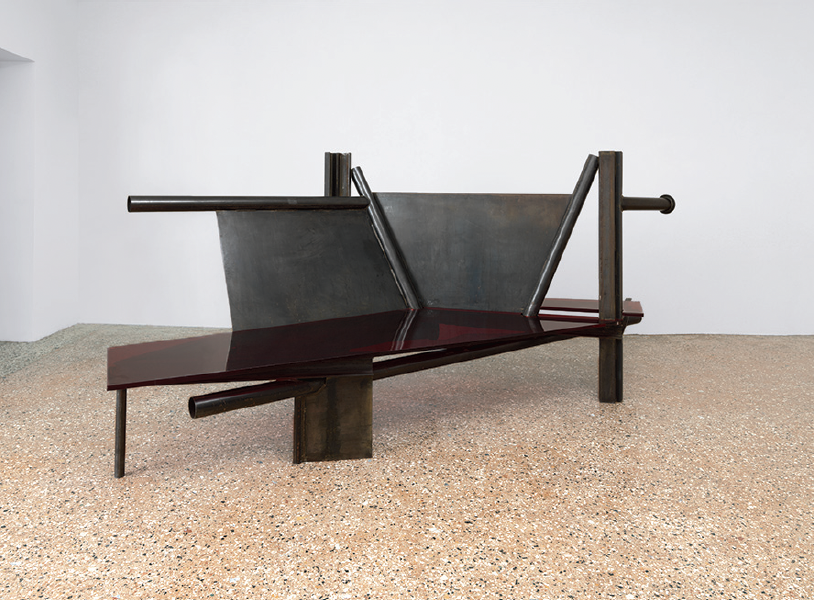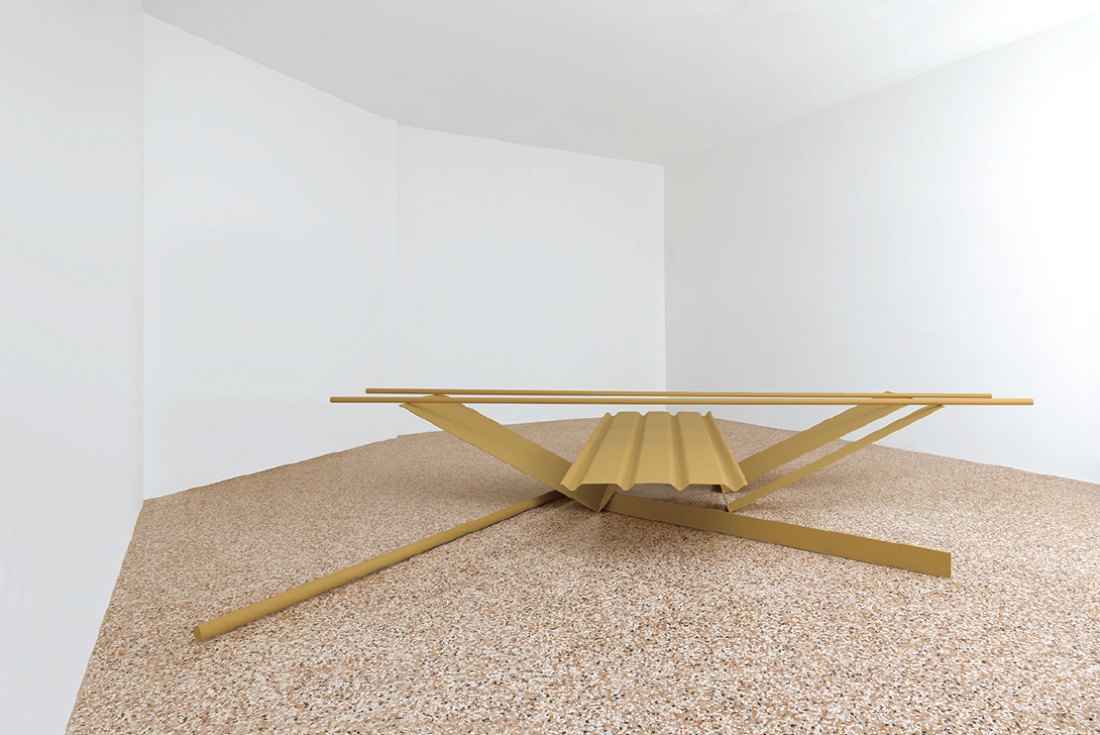Anthony Caro
Anthony Caro’s exhibition at the Museo Correr in Venice was not quite a full retrospective, but it did provide an excellent overview of his contribution to contemporary sculpture. There were works in various media from the last five decades or so of his career, some with a Canadian connection. One was made in Canada (Emma Push Frame, 1977– 78), and two are owned by David and Audrey Mirvish of Toronto.
Caro’s oeuvre is distinguished by its extraordinarily vast range. He continually reinvented himself in his choice of materials, syntax and even his attitude towards the medium itself. As Michael Fried observes in the catalogue, the exhibition seems like that of “an entire school of artists” rather than of “a single individual.”
There were sculptures made of paper (sometimes combined with empty picture frames), aluminum, welded steel and wood, and one included a large translucent slab of Perspex. Caro has also worked with bronze, clay and many different found objects: scissors, propeller blades and so on. Caro’s maxim was “Sculpture can be anything, so long as it’s expressive.”

Anthony Caro, Venetian, 2011–12, steel and Perspex, 178 x 432 x 179 cm. Collection of Audrey and David Mirvish, Toronto, ©Barford Sculptures Ltd. Photograph: Mike Bruce, courtesy Gagosian Gallery.
Caro’s syntax has been both highly inventive and consistently inconsistent. In the early 1960s Caro was “tracking” various elements along a central axis. With “tabling,” he allowed elements of the sculpture to dip below the surface they were placed on, as in the splendid Orangerie, 1969. For many viewers the signature Caros would be those welded-steel sculptures with airy, linear drawing in space, such as the celebrated Early One Morning, 1962, (not in the exhibition), Hopscotch, 1962, and Orangerie. They can be surprisingly spare, like Sight, 1965–69, with its mere two elements: a hollow metal tube lying on the floor, grounded, as Fried puts it, and a much thinner element rising at an angle into the space above. Or, they can have the complexity of Hopscotch, with an array of more than two dozen aluminum tubes, rods and corrugated sheets going off in numerous, seemingly random directions. (The unity of Caro’s sculptures is often difficult to grasp at first.)
These signature works are in the cubist-constructivist tradition stemming from Picasso, Gonzalez and David Smith, but Caro found new, fecund possibilities within it. His sculptures are not on a base, inhabiting a world of their own, but instead incorporate the floor as a vital reference point within the work. Rather than having the vertical orientation and frequent anthropomorphism of David Smith, who once stated that all his sculptures were “girl sculptures,” Caro’s sprawl horizontally along the floor and are much more abstract, with “a radical unlikeness to nature,” as Clement Greenberg once observed.
In large measure that abstractness owes to Caro’s choice of vocabulary. The I-beams, steel plates, tubes, rods and steel mesh that Caro has used have no inherent interest but were chosen for their syntactical potential—for their combinability. They preclude both literary associations and affectivity.
Michael Fried has argued both for that heightened abstractness and for some mitigation of it. In Artforum in 1968 he found in Caro “a preoccupation with particular modes of being in the world.” By 1970 he was offering examples: “entering, going through, being enclosed.” Fried was probably not espousing a new kind of imitation theory, but neither did he clarify at the time how Wittgenstein’s philosophy informed his analysis.
Regrettably, Museo Correr had none of the magnificent Trojan War sculptures, 1993–94, in which some degree of figuration returned and the vocabulary was chosen for its emotional freight; a whole other Caro appeared, one who manifestly meditated on human mortality.

Anthony Caro, Cadence, 1968–72, painted steel, 126 x 570 x 503 cm. Private collection, ©Barford Sculptures Ltd. Photograph: Mike Bruce, courtesy Gagosian Gallery.
The syntax of Duccio Variations No. 1, 1999–2000, is at the opposite pole from that of Orangerie. The signature Caros could be viewed as a creative criticism of David Smith’s tendency to enclose space, as he did in the Cubi. But this later work rejects drawing in space in favour of enclosed volumes that we can barely see into, providing an impression of almost claustrophobic heaviness. Perhaps it’s a return to the aesthetic of the earliest works in the exhibition, the equally claustrophobic Picassoid drawings from 1955–56, which press against the limits of the paper so that the figures seem crushed and compressed within their allotted space.
Caro’s attitude towards the medium has been equally liberal. The signature Caros are distinctive for how they rigorously explore and exploit the inherent properties of the medium. As Walter Pater observed in The Renaissance, 1873, an essential aspect of sculpture as a medium is the sheer facticity of its mass, against which, Pater argues, “all noble sculpture constantly struggles.” To him, therefore, an essential relationship of sculpture as sculpture is that between real and perceived mass.
In a 1972 interview with Phyllis Tuchman published in Artforum Caro said, “All sculptors have dreams of defying gravity.” His goal was “to make sculpture which is very corporeal but denies its corporeality.” But how?
High-key colour can contribute to a sense of incorporeal weightlessness, as it does in the splendid Red Splash, 1966. Fried pointed out in “Two Sculptures by Anthony Caro” (Artforum, 1968) how a shift towards lighter colour at the top of a sculpture can do the same, as can making the floor appear not as the support but rather the lowest level of the sculpture. Fried argues that the “physicality” of Prairie, 1967, (not in the exhibition, although a closely related work, Cadence, is) becomes “unperspicuous,” that his sculptures are perceived “as if in the absence of gravity” and “as if they weighed nothing.”
Caro’s modernist rumination on the essence of sculpture and his goal to make pure, quintessential sculpture was startlingly reversed in what he calls his “sculpitecture.” Child’s Tower Room, 1983–84, approximates the condition of a child’s playhouse and gives the impression that one could enter it and climb to the top, although in fact, the way is blocked.
It’s hard to imagine a more inventive sculptor, lauded by Michael Fried as “one of the greatest artists of our time.” His death at age 89 on Oct. 23, 2013, while still at the height of his powers, is an enormous loss. ❚
“Caro al Museo Correr” was exhibited at the Museo Correr in Venice, from June 1 to October 27, 2013.
Ken Carpenter has been Guest Critic at the Emma Lake Artist’s Workshop, Chair of the Visual Arts Department at York University and President of the Canadian Section of the International Association of Art Critics.

